Matthew 6:33
Not sure if there was a perfect parallel between the Hobbit’s Shire and the land we passed through today. It was close. The Bierzo region in northwest Spain is a geographic anomaly. It is almost entirely surrounded by mountains with the plains of the Meseta to the east and the Atlantic dominated Galicia to the west and north. It has its own microclimate that is suitable for high quality wine because of the moderating conditions created by the mountains. It also seems to grow any fruit with a pit and plenty of row crops. Everyone but the big city dwellers of which there is one, Ponferrada, enjoy garden patches outside their towns. The region is officially a Shire of Leon but seems far removed from that city except for the signs that proclaim its subservience to Leon.
We spent a delightful last night at the local wine festival and found some good stuff that is available in the US. They are quite proud of their wines made from the Mencia grape and insist that it is only grown in the Bierza. Geneticists know that it has the identical DNA to the Jaen grape in Portugal but I was not going to disagree with the locals. We did not make it to the end of the festival. Some in our hotel did and returned noisily around midnight. That is still early by Spanish standards for a Saturday night. Slept well anyway.
Left without breakfast around 7:15 and walked through a very quiet town. Started a long gradual climb alongside a road toward the town of Pieros where we treated ourselves to ham and eggs. Continued on through vineyards and a somewhat dicey highway path until we diverted across the road onto a dirt path towards Villafranca del Bierzo. This is not our first Villafranca. There are quite a number on the Camino Frances. Evidently, conditions in 12th Century France were so crowded that it was easy to entice French and other settlers to these underpopulated regions.
The town of Villafranca has around 5000 inhabitants nestled along the river Burbia which is joined by the River Valcarre that comes down from the mountains that we will be crossing. The town is one of those places that seems to endure the ages. It has few of the apartment flats and lots of wandering cobblestone streets. The storks have found a use for abandoned smokestacks from its industrial past.
Ponferrada, which housed the Templar Castle, was one of Europe’s industrial centers in the 18th and 19th centuries. The Bierzo is rich in coal, iron ore and gold. In fact, the Romans exploited the gold in this region for centuries. They developed techniques of hydraulic mining that would be emulated in California somewhat later. The mines themselves are off the Camino and we don’t walk more that a hundred yards off the Camino. From the pictures, they are like the ones in the Spartacus movie. They were worked by slaves, the Roman way. Like the gold mines, the coal and iron industries played themselves out by the 1950s. The entire region was economically depressed.
One industry that did continue to grow was wine. The original Bierzo vineyards were wiped out like much of European vineyards in the 19th Century by the Phyloxeria plague. The local grapes were then grafted onto New World disease resistant root stalk and the vineyards survived. Today agriculture and tourism have replaced heavy industry. Everything grows here except tropical stuff.
We left Villafranca and started to follow the Valcarce River along an almost disused highway. The new Autopista follows the same route up this valley but the beauty of the place cancels the intrusion. We had reached the heart of the Shire. Unlike the Meseta, we saw isolated farmhouses and amazing gardens alongside the river. What was really amazing was the variety fruits and berries growing untended alongside the road. I speculate that they are the product of pilgrims spitting out seeds and becoming established over the centuries. I know people in our mountain home that could easily live off the land harvesting the figs, cherries, stone fruits, apples, pears, berries and an entire pharmacy of medicinal plants that were there for the harvest.
Of course places like this are fought over. The Romans took almost 2 hundred years to pacify the locals. The region was spared the Muslim conquest for the most part because of its remoteness. However, the region became part of Leon and Spanish speaking Spain to the dismay of the local Celts. The Gallegos or Gauls or Galicians continue to hang on to their traditional culture. This includes their fascination with bagpipes like their relatives from Brittany and the British Isles. We will find out tomorrow as we cross the mountains again into Galicia.
The 25 km walk was warm but with quite a bit of shade as we walked through this river valley at the bottom of a mountain gorge. We reached our modern and not overly charming hotel by 1 or so. Showers and a statutory beer. Little Siesta and prepping for tomorrow. The climb will be around 700 meters and around 13 Kms in distance. Rain is in the forecast as we enter Galicia. We are ready and with less than 170 Kms to Santiago, we will do it.
The pictures include what I thought from a distance was the Mother of all Pallet piles. They turned out to be stacks of chestnut lumber that was stickered and drying. I have confess that the woodworker in me did covet those 2 to 4 inch thick planks of wonderful furniture wood.

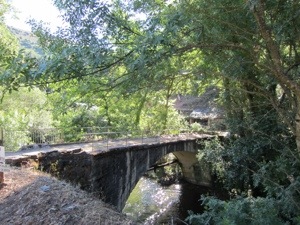
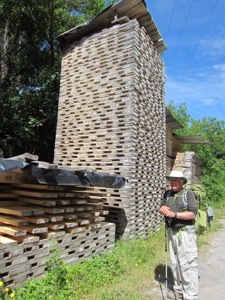
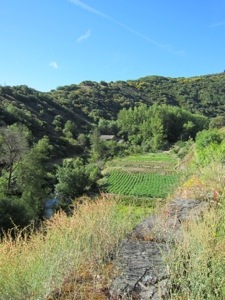
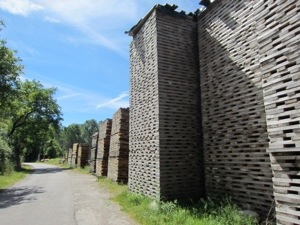
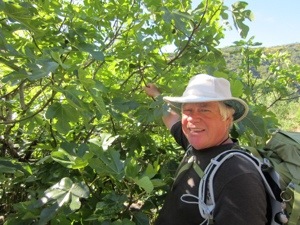
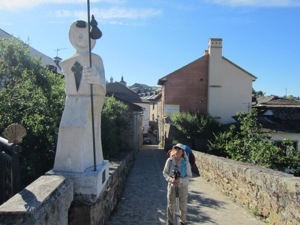
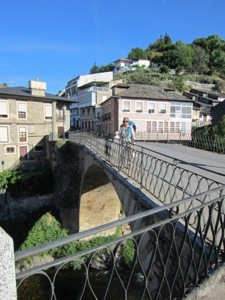
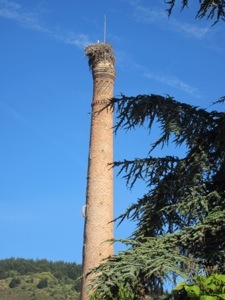
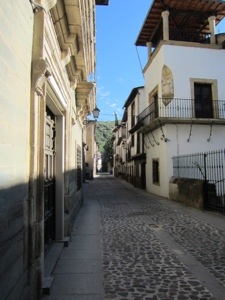
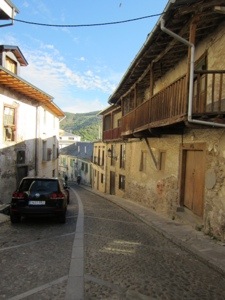
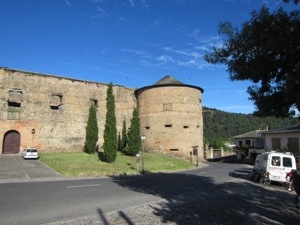

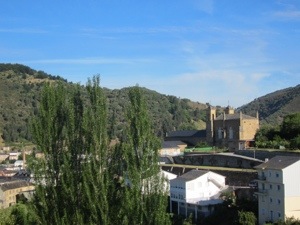
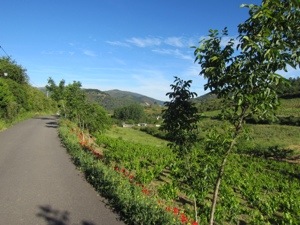
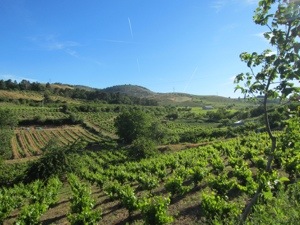
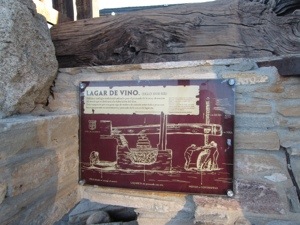
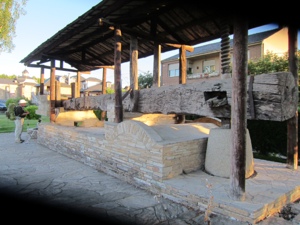

David and Leslie are back home and had a great trip. All OK here. Are you able to bring any of that good wine home?
Happy Father’s Day, Mark! David and I just had a wonderful celebratory dinner in Murphys at a new Sicilian restaurant. Your walk today was gorgeous. Such lovey, verdant land. We came home to see smoke in the air: first, as spot fire on the Parrots Ferry grade, attended by 7 trucks; then, distant smoke toward Yosemite–possibly the “control burn,” out of control, again? There’s a good strong wind to keep it going, too. Happy trails!
I imagine we are going to be seeing little Hobbit houses on the Ridge next.
Gorgeous country you are traveling.